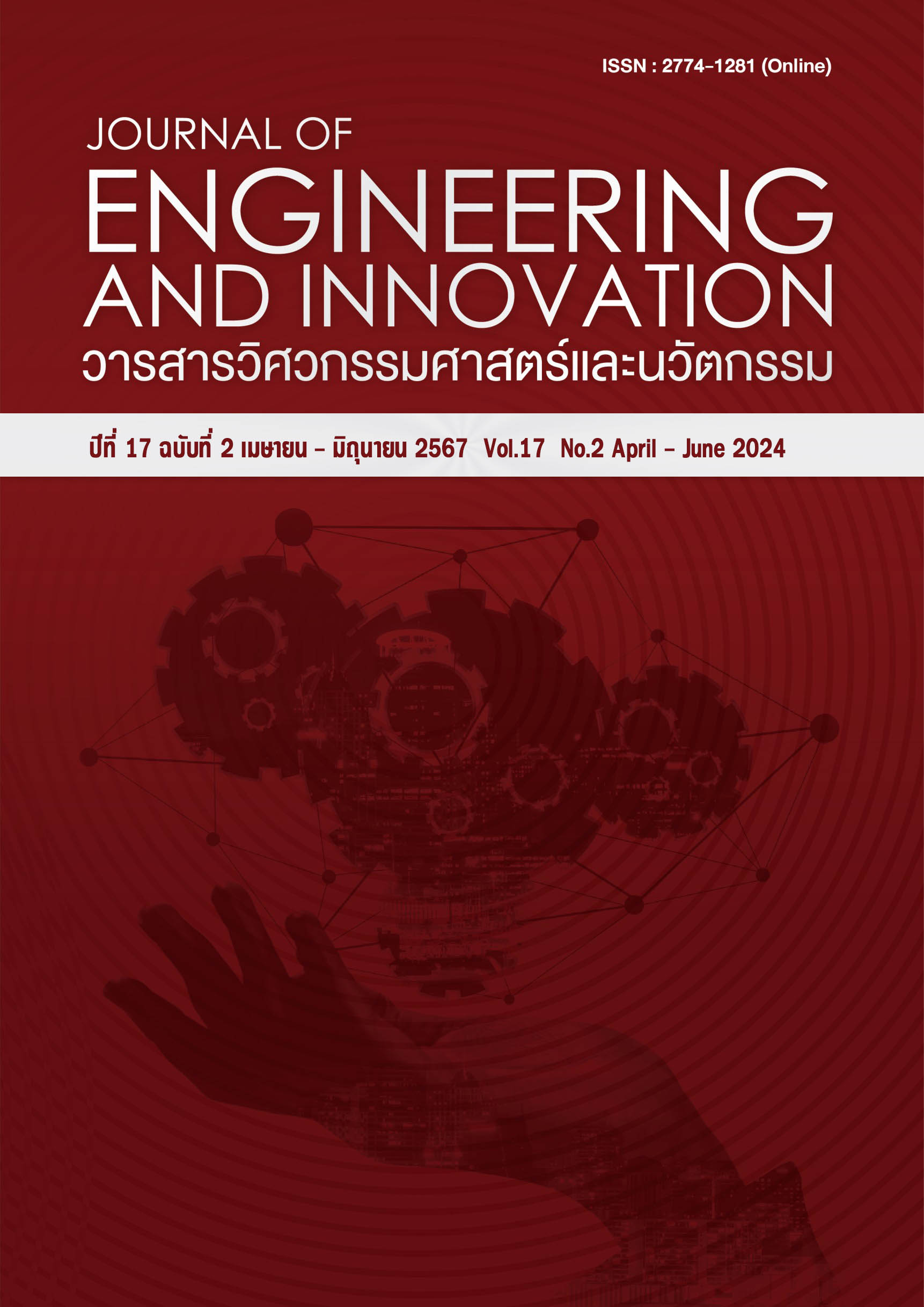A method for estimating dirt on photovoltaic panel using TCS3200 color sensor module
Main Article Content
Abstract
This paper presents the application of the TCS3200 color sensor module with Arduino ESP32 microcontroller to estimate the dirtiness of solar panels caused by dust. The surfaces of solar panels with different amounts of dust accumulation have different reflectance values. Therefore, this reflectance measurement instrument was designed using the TCS3200 color sensor module to measure the reflectivity in RGB values and convert it to gray scale values. The gray scale was then used to correlate with the amount of dust accumulated on the solar panels by experiments by simulating the dust situation on the solar panels at various levels ranging from 0 – 25 g/m2 on a 50 W polycrystalline solar panels. The results showed that the gray scale value measured by the TCS3200 color sensor module correlated with the amount of dust on the solar panel. When tested by measuring the short-circuit current and open-circuit voltage of the tested solar panel. It was found that the value decreased with the amount of dust on the solar panel inversely related to the gray scale. The maximum power output from the solar panel is 43.56 W when the solar panel is clean and free of dust. When the dust accumulation on a solar panel reaches 5 g or more, it initiates a decline in the power output generated by the panel. The power output reached its minimum value at 38.23 W when the dust accumulation on the solar panel reached 25 g/m2. The decrease in power is caused by the amount of sunlight reaching the solar panel is reduced because it is blocked by dust particles, causing the solar panel to lose its efficiency in receiving sunlight. The soil ratio of solar panels decreased inversely with the amount of dust. It was found that the soil ratio of the solar panels decreased inversely with the amount of dust. it can be inferred that the TCS3200 color sensor module is capable of measuring the difference in reflectivity caused by dust on the surface of the solar panel. This ability enables the module to estimate the level of dirtiness or dust accumulation on the solar panel surface. Therefore, the TCS3200 color sensor module can be used as a tool to assess the cleanliness of the solar panel surface based on its reflectivity readings.
Article Details
References
นรินทร์ ตันไพบูลย์. แนวโน้มธุรกิจ/อุตสาหกรรม ปี 2564-2566. เข้าถึงได้จาก: https://www.krungsri.com/th/research/industry/industry-outlook/Energy-Utilities/Power-Generation/IO/io-power-generation-21 [เข้าถึงเมื่อ 12 มิถุนายน 2565]
สำนักนโยบายและแผนพลังงาน. มติการประชุมคณะกรรมการบริหารนโยบายพลังงาน ครั้งที่ 46. เข้าถึงได้จาก: http://www.eppo.go.th/index.php/th/component/k2/item/18092-cepa-prayut46 [เข้าถึงเมื่อ 12 มิถุนายน 2565]
สำนักนโยบายและแผนพลังงาน. รายงานสถิติพลังงานรายปี 2564. เข้าถึงได้จาก: https://www2.energy.go.th/th/annual-energy-statistics-reportw [เข้าถึงเมื่อ 12 มิถุนายน 2565]
Bergin MH, Ghoroi C, Dixit D, Schauer JJ, Shindell DT. Large Reductions in Solar Energy Production Due to Dust and Particulate Air Pollution. Environ Sci Technol Lett. 2017 Aug 8;4(8):339–344.
นิพนธ์ เกตุจ้อย, มรุพงศ์ กอนอยู่. การศึกษาผลกระทบของฝุ่นบนแผงเซลล์แสงอาทิตย์ต่อการผลิตไฟฟ้า. วารสารวิทยาศาสตร์และเทคโนโลยี มหาวิทยาลัยมหาสารคาม. 2556; 32(5): 555–562.
Hammoud M, Shokr B, Assi A, Hallal J, Khoury P. Effect of dust cleaning on the enhancement of the power generation of a coastal PV-power plant at Zahrani Lebanon. Solar Energy. 2019; May 15; 184: 195–201.
เกตุวดี วงศ์ปน, ปิยะ ชัยมงคล, อัครินทร์ อินทนิเวศน์. ผลของการทำความสะอาดโดยใช้น้ำที่มีต่อประสิทธิภาพของแผงเซลล์แสงอาทิตย์. ใน: การประชุมวิชาการระดับชาติ มหาวิทยาลัยเกษตรศาสตร์ วิทยาเขตศรีราชา ครั้งที่ 3. ชลบุรี: 2561. หน้า. 76–83.
Roy S, Mandal M, Jena C, Sinha P, Jena T. Programmable-Logic-Controller Based Robust Automatic Cleaning of Solar Panel for Efficiency Improvement. In: 2021 International Conference in Advances in Power, Signal, and Information Technology (APSIT). 2021. p. 1–4.
พงษ์ศักดิ์ ทามแก้ว, ประจวบ อินระวงศ์, กาณฑ์ เกิดชื่น. การประมาณค่าความสกปรกบนแผงโซล่าเซลล์ด้วยกระบวนการทางภาพ. ใน: การประชุมวิชาการระดับชาติวิศวกรรมวิจัย ครั้งที่ 1 ชลบุรี. 2560. มหาวิทยาลัยเทคโนโลยีราชมงคลธัญบุรี; 2560. หน้า. 14–17.
Nguyen TT, Nguyen TT, Nguyen VT, Cao CC, Hua J. Application of Arduino Control Mainboard with Color Light Sensor TCS3200 in Color Recognition of Edge Banding in Laser Edge Banding Machine. IOP Conference Series: Earth and Environmental Science. 2019; 252(2): 1-10. Available from: doi: 10.1088/1755-1315/252/2/022130 [Accessed 12th July 2022]
อนุชา ดีผาง และชัยพร อัดโดดดร. (2565). การออกแบบและสร้างเครื่องทำความสะอาดแผงเซลล์แสงอาทิตย์ความเร็ว 3 ระดับแบบอัตโนมัติที่ควบคุมด้วยไมโครคอนโทรลเลอร์. วารสารวิชาการ เทคโนโลยี พลังงานและสิ่งแวดล้อมบัณฑิตวิทยาลัย วิทยาลัยเทคโนโลยีสยาม, ปีที่ 9(1), 56-69.
Gostein M, Littmann B, Caron JR, Dunn L. Comparing PV power plant soiling measurements extracted from PV module irradiance and power measurements. In: 2013 IEEE 39th Photovoltaic Specialists Conference (PVSC). 2013. p. 3004–3009.
Fernández-Solas Á, Micheli L, Almonacid F, Fernández EF. Indoor validation of a multiwavelength measurement approach to estimate soiling losses in photovoltaic modules. Solar Energy. 2022 Jul 15; 241: 584–591.

